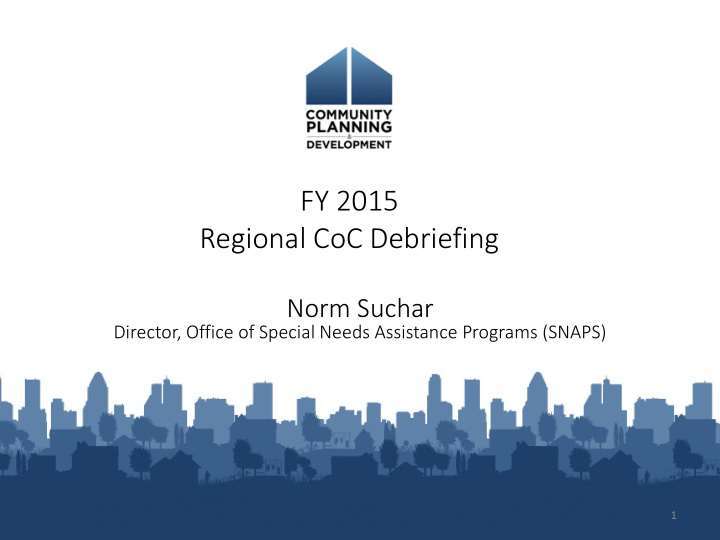



FY 2015 Regional CoC Debriefing Norm Suchar Director, Office of Special Needs Assistance Programs (SNAPS) 1
Submitting Questions • Due to the high volume of participants, all participants will be muted throughout the presentation. • Questions can be posted at any time during the webinar via the “Questions” pane of Go -to-Meeting. • All questions that we do not have time to respond to should be submitted via the Ask A Question section on the HUD Exchange — Select Continuum of Care Program from drop- down menu. 2
Opening Doors: Federal Strategic Plan to Prevent and End Homelessness There are four major goals in Opening Doors : 1. End chronic homelessness 2. End veteran homelessness 3. End family and youth homelessness 4. Set a path to ending all homelessness The U.S. Interagency Council on Homelessness (ICH) is tracking the progress through HUD’s annual point-in-time (PIT) data 3
Funding Overview Total Awarded: $1.94 billion • 7,616 New and Renewal projects • $260 million awarded to new PH projects via reallocation and PH Bonus – $160 million increase in PSH – $100 million increase in RRH We estimate that awards will provide housing to 25,000 more people than in 2014. 4
Policy Priorities 1. Strategic Resource Allocation 2. Ending Chronic Homelessness 3. Ending Family Homelessness 4. Ending Youth Homelessness 5. Ending Veteran’s Homelessness 6. Using a Housing first Approach 5
Tier 1 and Tier 2 • Tier 1 Projects – 85 % of CoC’s ARD – Safe • Tier 2 Projects – Tier 2 projects compete for funding – Impacted by CoC score and other factors • Projects straddling Tier 1 and Tier 2 6
Overview of Selection and Ranking Within the rank order established by the CoC on the Priority Listing, HUD awarded a point value to each new and renewal project application in Tier 2 using a 100 point scale: • CoC Score – Up to 60 points • CoC Project Ranking - Up to 20 points • Project Type - Up to 10 points • Commitment to Housing First - Up to 10 points 7
How did CoCs do well? CoCs that scored well and received increased funding did the following: • Reallocated lower performing projects, especially TH and SSO projects • Used performance criteria to rate and rank projects • Used Housing First practices • Reduced homelessness in their communities 8
Why weren’t my projects funded? CoC’s overall Performance • CoCs that scored poorly were less likely to get projects funded – Increase in homelessness in the CoC’s geographic area – Poor strategies to reduce length of time individuals experience homelessness – Poor strategies to reduce returns to homelessness – Strategies to prevent and end homelessness were inadequate – Not using evidence-based practices 9
Why weren’t my projects funded? (cont.) Project Performance – TH and SSO projects were less competitive; many projects of these would have been funded if they had been reallocated – Projects lost points for not using Housing First practices – Projects that were at the bottom of their CoC’s Tier 2 were unlikely to be funded 10
Reallocation • Encourages Performance-based prioritization – CoCs can eliminate lower performing projects – CoCs can eliminate lower performing types of projects • On Average, CoCs reallocated 6.7% of their resources • Through reallocation, communities funded $116 million in new projects, including: – $48 million for Permanent Supportive Housing – $46 million for Rapid Rehousing – $19 million for new Coordinated Assessment – $4 million for new HMIS 11
Transitional Housing HUD is funding just over half as much transitional housing as last year • $155 million less awarded to transitional housing projects Of the $155 million reduction, nearly half was reallocated locally, and the rest were in Tier 2 and not selected • Youth transitional housing programs were seldom cut 12
Transitional Housing (cont.) HUD is encouraging CoCs to reduce transitional housing, but there are important considerations: • Review HUD’s Recovery Brief • Can TH be used as short term crisis housing to help reduce unsheltered homelessness or provide safety for people fleeing DV • Ensure that TH programs are helping people move quickly into permanent housing • Continue to review TH programs that serve youth 13
Guidance for Grants not Funded • Extending Grants with funds remaining • Grant Closeouts • Exiting program participants from projects • Restrictive Covenants 14
Questions? 15
Moving Forward CoCs Should Focus on: Reducing Homelessness Monitoring Performance Reallocation Reducing Barriers Targeting Resources to people with the highest needs 16
Recommend
More recommend